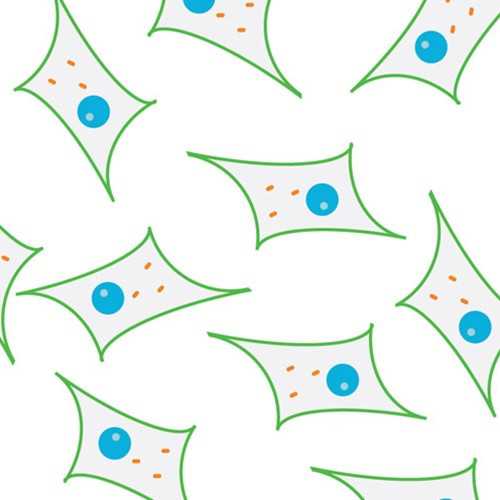NIH 3T3 Duo-BFP53BP1 Cell Line
The NIH 3T3 Duo-BFP53BP1 Cell Line allows for the direct study of the dynamics of single double-strand breaks (DSBs) and translocations in living mammalian cells in vivo.
NIH3T3 cells which contain integrated into chromosome 7 the ISceI restriction endonuclease site adjacent to an array of the Lac-operator DNA sequence (LacO, 256 copies) and three integrations on chromosomes 1 and 10 (integrations on two chromosome homologs) of the TetO-ISceI-TetO array (TetO, 96 copies). This cell line also coexpresses the fluorescent repressors LacR-GFP and TetR-mCherry and the DNA repair protein (mouse) 53BP1 tagged with the fluorescent protein tagBFP.
From the laboratory of Tom Misteli, PhD, National Cancer Institute/NIH.
 Part of The Investigator's Annexe program.
Part of The Investigator's Annexe program.
The NIH 3T3 Duo-BFP53BP1 Cell Line allows for the direct study of the dynamics of single double-strand breaks (DSBs) and translocations in living mammalian cells in vivo.
NIH3T3 cells which contain integrated into chromosome 7 the ISceI restriction endonuclease site adjacent to an array of the Lac-operator DNA sequence (LacO, 256 copies) and three integrations on chromosomes 1 and 10 (integrations on two chromosome homologs) of the TetO-ISceI-TetO array (TetO, 96 copies). This cell line also coexpresses the fluorescent repressors LacR-GFP and TetR-mCherry and the DNA repair protein (mouse) 53BP1 tagged with the fluorescent protein tagBFP.
From the laboratory of Tom Misteli, PhD, National Cancer Institute/NIH.
 Part of The Investigator's Annexe program.
Part of The Investigator's Annexe program.
This product is for sale to Nonprofit customers only. For profit customers, please Contact Us for more information.
| Product Type: | Cell Line |
| Name: | NIH 3T3 Duo-BFP53BP1 |
| Cell Type: | NIH3T3 mouse embryonic fibroblasts |
| Accession ID: | CVCL_HC52 |
| Morphology: | Fibroblast |
| Source: | mouse embryo (NIH3T3 cells) |
| Organism: | Mouse |
| Biosafety Level: | BSL1 |
| Growth Conditions: | High-glucose DMEM, 10-15% FBS, P/S, Glutamine, 5mM IPTG, 1ug//ml Doxycycline, 400ug/ml Hygromycin, 300ug/ml Zeocin, 2ug/ml Puromycin, 600ug/ml Geneticin, 10ug/ml Blasticidin (See also Additional comments below) |
| Subculturing: | Split 1 to 3 when ?90% confluency |
| Cryopreservation: | 15% DMSO in FBS |
| Storage: | Liquid nitrogen |
| Shipped: | Dry ice |
We culture the cells in the presence of IPTG and Doxycycline to prevent the binding of the repressors to the respective operators. In order to visualize the arrays wash IPTG and Doxycycline as explained in the protocol (Roukos et al., Nat Protoc. 2014). We routinely culture the cells in the presence of Blasticidin to select for cells expressing BFP53BP1. BFP53BP1 is expressed in very low levels and only in a subpopulation of cells even after Blasticidin selection. We routinely resort the cells by FACS to enrich our population for BFP53BP1 expressing cells. The selection using hygromycin, zeocin, Puromycin, Geneticin is not essential. FACS is used to resort cells expressing the desired levels of LacRGFP/TetmCherry.
- Roukos V, Voss TC, Schmidt CK, Lee S, Wangsa D, Misteli T. Spatial dynamics of chromosome translocations in living cells. Science. 2013 Aug 9;341(6146):660-4. doi: 10.1126/science.1237150.
- Roukos V, Burgess RC, Misteli T. Generation of cell-based systems to visualize chromosome damage and translocations in living cells. Nat Protoc. 2014 Oct;9(10):2476-92. doi: 10.1038/nprot.2014.167. Epub 2014 Sep 25.
If you publish research with this product, please let us know so we can cite your paper.


